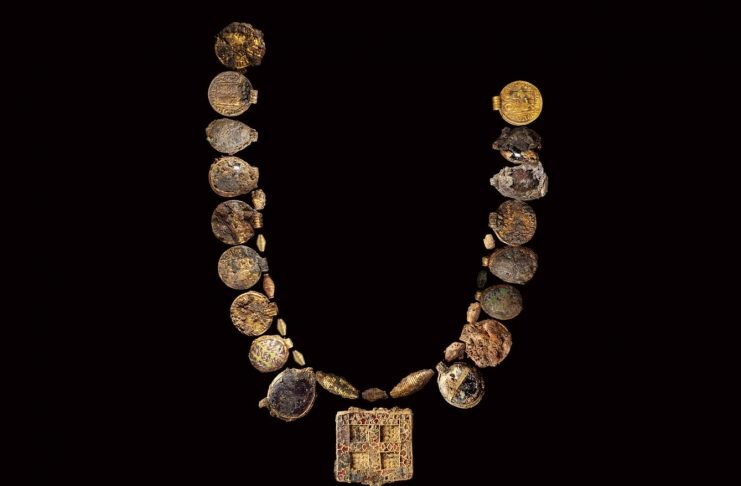
© RPS
Archaeologists from MOLA (Museum of London Archaeology) have uncovered an ornate 1300-year-old gold and gemstone necklace during excavations in Northamptonshire, England.
The necklace was discovered in
the burial of a high-status female burial from the early Medieval period, during preliminary works in preparation for a housing development by the Vistry Group.
The necklace, described as a "once in a lifetime" find,
has 30 pendants and beads made from Roman coins, gold, garnets, glass, and semi-precious gemstones. A rectangular pendant with a cross motif forms the centrepiece of the necklace and is inlaid with red garnets set in gold.
The find is part of a collection of grave goods still being investigated that has been dubbed the 'Harpole Treasure', based on the name of the local parish. Experts have stated that
the female burial is one the most significant from the period ever discovered in Britain.
Similar early Medieval necklaces have found at other sites across England, with
the closest parallel being the Desborough necklace, found in Northamptonshire in 1860 and now in the British Museum's collections.
Levente-Bence Balázs from MOLA said: "When the first glints of gold started to emerge from the soil, we knew this was something significant. However, we didn't quite realise how special this was going to be. We are lucky to be able to use modern methods of analysis on the finds and surrounding burial to gain a much deeper insight into the life of this person and their final rites."
Archaeologists also found two decorated pots and a shallow copper dish, while x-rays taken on blocks of soil lifted from the grave (that are currently being micro-excavated), shows an elaborately decorated cross, featuring highly unusual depictions of human faces cast in silver.The skeleton has fully decomposed leaving only tiny fragments of tooth enamel, however, the researchers believe that the woman
may have been an early Christian leader of high standing, or possibly an abbess or royalty.
MOLA Conservators are currently analysing the finds and are looking for traces of organic remains within the burial. It is
possible that the woman was placed on a bed within the grave and traces of soft furnishings may be found.
Liz Mordue, Archaeological Advisor for North Northamptonshire Council concludes: "This is an exciting find which will shed considerable light on the significance of Northamptonshire in the Saxon period. It also serves as a reminder of the importance of archaeology in the planning and development process."
Comment: See also: Secrets of the exceptional diatretic vase revealed, recently discovered at 4th century Paleo-Christian necropolis in Autun, France